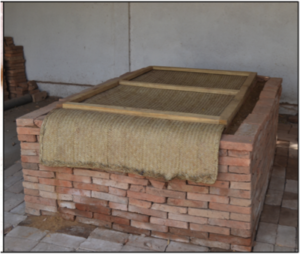Zero energy cool chamber – an on-farm rural oriented storage structure that operates on the principle of evaporative cooling was developed at IARI, New Delhi, using locally available raw materials such as bricks, sand, bamboo, dry grass, jute cloth etc. The chamber is an above-ground double-walled structure made up of bricks. The cavity of the double wall is filled with riverbed sand. The lid was made by using dry grass/straw on a bamboo frame. The rise in relative humidity (90% or more) and fall in temperature (10–15°C) from the ambient condition could be achieved by watering the chamber twice a day. The major advantage of cool chamber storage was the maintenance of fruit firmness by lowering the physiological loss in weight (PLW) and other metabolic processes.
Construction
- Select a raised site close to a source of water.
- Make a floor with bricks.
- Erect a double wall 70 cm high, leaving a cavity 7.5 cm wide between the two walls.
- Drench the chamber with water.

- Soak fine, river-bed sand with water.
- Fill the cavity between the double wall with this wet sand.
- Make a cover frame of bamboo, sirki, straw, or dry grass.
- Build a thatched-roof shed over the chamber to shield the chamber from direct sun and rain.
Operation
- Keep the sand, bricks, and top cover of the chamber wet.
- Water twice daily, in the morning and evening. A drip system can be built with plastic pipes, microtubes connected to an overhead water source.
- Store your fruits and vegetables in perforated plastic crates. Do not use bamboo, wood, or fibreboard boxes because these will be damaged by moisture.
- Cover these crates with a thin polyethylene sheet.
- Rebuild the chamber with new bricks after 3 years. (The bricks’ pores become blocked over time and this reduces the chamber’s effectiveness. )
Advantages
- Can be constructed by an unskilled person No mechanical or electrical energy is needed.
- Allows small farmers to store produce for a few days and thus avoid costly rush selling.
- Ideal for household storage.
- Reduces losses and thus pays for itself in a short time.
- Useful for the temporary storage of curd, milk, and cooked food.
- Can also be used for mushroom cultivation, raising silk – worms, and storage of biofertilisers.
Disadvantages
- Requires a significant capital investment
- Operation relies on a reliable source of water throughout the year.
